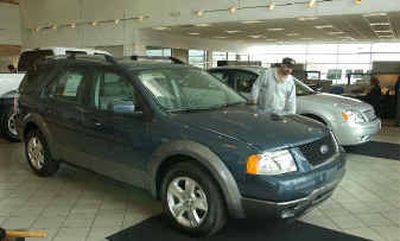Auto sales expected to fall

DETROIT — After a sizzling September, U.S. sales of new cars and trucks likely cooled in October, more so for Detroit’s Big Three carmakers than foreign brands, analysts say.
Heavy-but-costly incentive spending at the end of September likely pulled ahead a portion of October sales for some automakers, while sagging consumer confidence may have hurt business, observers say. Major automakers report October results Wednesday.
New vehicle sales surged in September to their second-highest level of 2004, climbing to a seasonally adjusted annual sales rate of 17.5 million units.
Predictions vary for October, but the consensus appears to be in the mid-16 million unit range, up from 16.1 million a year ago.
“October sales will be below September’s levels but still sustained at high levels by incentive spending,” Merrill Lynch analyst John Casesa said in a research note.
Casesa cited as a concern the significant drop last month in the University of Michigan’s consumer sentiment index, which he pegged to worries about high energy prices and said “could make the payback for September more severe.”
Casesa expects each of Detroit’s automakers — General Motors Corp., Ford Motor Co. and DaimlerChrysler AG’s Chrysler Group — to post year-over-year sales declines for October. His predictions: GM down 5 percent, Ford down 9 percent and Chrysler down 2 percent.
Among foreign brands, Casesa predicts double-digit gains for Toyota Motor Corp. and Nissan Motor Co., and slight increases for Honda Motor Co. and Subaru of America Inc.
Credit Suisse First Boston analyst Chris Ceraso forecasts GM’s October sales to be flat to down 2 percent, Ford down 6 percent to 8 percent and Chrysler up 2 percent to 4 percent. He expects foreign brands to be up 2 percent to 4 percent as a whole.
In September, lifted by a late-month clearance sale on 2004 models, GM’s new vehicle business rose a hefty 20 percent. Toyota, Nissan and Chrysler also posted double-digit gains, but Ford struggled again despite incentive offers much the same as GM’s.
GM and Ford both have launched several new vehicles in recent months, but many of the offerings are just beginning to reach showrooms in significant numbers.
Ford, which sorely needs a boost from its new Five-Hundred flagship sedan and Freestyle crossover vehicle, said October sales of those two models — their first full month on the market — had exceeded company expectations.
The nation’s second-largest automaker behind GM said it has taken 50,000 orders for the Five-Hundred and 30,000 orders for the Freestyle. Ford’s U.S. sales for the first nine months of 2004 were off 5 percent from a year ago.
Despite production cuts by GM and Ford to help reduce bloated inventories, Ceraso said it’s looking “increasingly likely the Big 3 will end the year with too much inventory.”
“That will put pressure on North American production schedules in 2005 and could produce some downward revisions to earnings expectations,” he said.
On the New York Stock Exchange, GM shares rose 79 cents to close Monday at $39.34, Ford shares rose 20 cents to close at $13.23 and DaimlerChrysler shares rose 45 cents to close at $41.90.